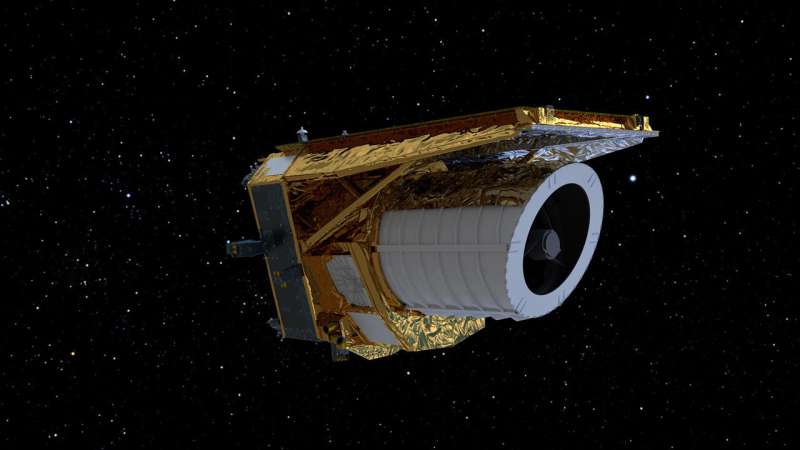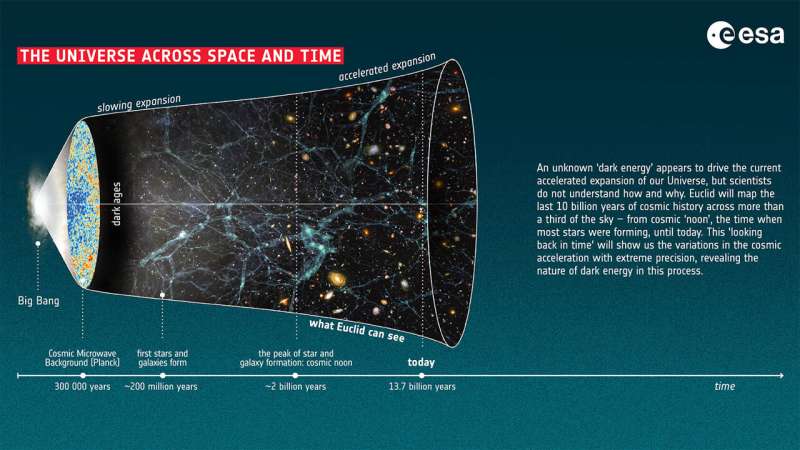This article has been reviewed according to Science X's editorial process and policies. Editors have highlighted the following attributes while ensuring the content's credibility:
fact-checked
trusted source
proofread
Euclid space telescope to shed light on the darkness

On 1 July, the Euclid space telescope will start its journey into outer space on an important mission—to seek further clues about the origin of the universe. UZH researchers are involved in the scientific preparation and evaluation of the mission as part of a project led by the European Space Agency (ESA).
Shining stars, mysterious nebulae and faraway galaxies—images from space fire our imagination and spark fantasies about extraterrestrial life. But the visible matter known to researchers is actually only around 5% of the universe; 95% of the universe is a proverbial black box. Two invisible factors—called dark matter and dark energy—influence the arrangement of objects in space and the expansion of the universe.
The Euclid space telescope is now prepared to shed light on the darkness: on 1 July 2023, it will start its mission to record, in a 3D map, the large-scale structure of galaxies up to 10 billion light years away from Earth. Researchers hope that this unique recording of the cosmic web will reveal more about the nature of dark matter and dark energy as well as the laws of gravity.
Indirect observation through magnifying glass effect
"Dark matter is matter that does not emit, absorb or reflect light," explains Francesca Lepori, cosmologist at the Center for Theoretical Astrophysics and Cosmology at UZH. Because it is invisible, it's difficult for researchers to study it. But it seems clear that there must be something else there: "The observed arrangement of galaxies cannot be explained by general relativity—unless there is more mass than we can see," says Lepori.
The only way to study dark matter is through its interaction with the gravitational force. On board Euclid, therefore, is an instrument called a VISible (VIS), which can image galaxies with tremendous precision. "From the pictures, we will measure how distorted the galaxies appear," explains Lepori. This distortion takes place because of an effect called gravitational lensing: mass that lies between the telescope and the observed galaxy deflects the light like a magnifying glass, making the galaxy behind it appear distorted. "This effect will give us information about how much dark matter lies between Euclid and the observed galaxy," says the cosmologist.
Dark energy dominates
Since 1998, researchers have been working on another invisible phenomenon that cannot be explained by Einstein's theory of general relativity. Based on measurements of exploding, extremely bright stars (supernovae), two research groups have found that the expansion of the universe is not slowing down—as previously assumed—but accelerating. "This acceleration started about 5 billion years ago," Lepori says. "You would not expect this of ordinary and dark matter. We attribute the cause of the accelerated expansion to an exotic form of energy called dark energy."
The simplest description researchers currently have for dark energy is the cosmological constant: it states that the density of dark energy does not change over the entire evolution of the cosmos. As Euclid looks back to the beginnings of the universe 10 billion years ago by observing very distant galaxies, researchers can investigate whether dark energy has indeed not changed over time.
Seeing red can be instructive
The researchers hope to obtain more conclusive data about the expansion of the universe and the dark energy driving it from the second instrument on board Euclid. This is a near-infrared spectrometer and photometer (NISP), with which the researchers can evaluate a phenomenon called the red shift. Similar to the Doppler effect of light, galaxies moving away from us appear "redder" because the received wavelength gets stretched. "The farther a galaxy is away from us, the faster it is moving away from Earth," says Lepori. "From the red shift we can therefore deduce the distance to the galaxy and obtain information about the expansion of the universe."
However, Lepori is not yet ready to accept the simple model of the cosmological constant. "I hope that Euclid will give us some new input," she says. "For example, whether the density of dark energy has changed in the course of the evolution of the universe."
Euclid could also provide crucial clues about Einstein's theory of general relativity. "The laws of gravity only work at huge scales if we introduce the dark components," Lepori explains. But, she says, it is also possible that on a cosmic scale, general relativity is not yet correct. "Researchers have developed many complex models of modified theories of gravity," Lepori says. "But now we need the observations of Euclid to point us in the right direction."

Contributions from UZH
Lepori and nine other UZH researchers are participating in the scientific evaluation of the space mission. More than 2,600 researchers from 100 institutes in Europe, the U.S., Canada and Japan are part of the ESA's Euclid Consortium. They are working on a wide range of questions, from defining the scientific objectives and constructing the measuring instruments to analyzing and evaluating the data.
"As part of the Theory Working Group, I am investigating which effects of general relativity are central to Euclid and should be considered in the analysis," Lepori says about her role. She is a postdoctoral researcher under SNSF-Eccellenza Professor Julian Adamek, who contributes to the Euclid mission with his numerical simulations. Adamek has developed a code that replicates the 3D distribution of matter under general relativity as well as under modified gravitational theories.
UZH researchers are also involved in other ways. A simulation by UZH computer cosmologist Joachim Stadel and high-performance computing specialist Doug Potter maps all the galaxies that Euclid could potentially observe. Among other things, it is used to test how well the analysis tools deal with immense amounts of data. Astrophysics professor Aurel Schneider, meanwhile, is running through different dark matter scenarios and investigating what effects they have on cosmological observations. Further contributions to the Euclid Consortium are made by UZH researchers Giovanni Arico, Jeppe Mosgaard Dakin, Sebastian Schulz, Jozef Bucko and Jaiyul Yoo.
Data pipeline in the works
When Euclid starts its journey into space in July, the work of the UZH researchers will not change straight away. In addition to exploring what can be learned from Euclid, they are currently working on the methodology and tools to process and analyze Euclid's data. "As soon as the first data package reaches us, we will be fully focused on its analysis," says Lepori. The first images from Euclid are expected by the end of the year.
The Big Bang
Currently, the best proven model for the origin of the universe is the Big Bang theory. It describes the development of the universe after the Big Bang 13.7 billion years ago when matter, space and time came into being. "The Big Bang is not necessarily the beginning of the universe, but a point in time before which we cannot say anything scientifically because it is not accessible to our observation," explains cosmologist Francesca Lepori.
In the first phase after the Big Bang, the universe expanded rapidly. At this point, it consisted of an almost homogeneous plasma of elementary particles. Only when the universe cooled down more and more did the first atoms form and photons were able to split off. This was followed by the so-called "Dark Ages," in which there were still no galaxies and no visible light sources.
About 200 million years after the Big Bang, stars and galaxies began to form. Under the force of gravity, the individual galaxies increasingly formed a large-scale structure that resembles a network of nodes and connections—it is therefore also called the cosmic web. In between there are almost matterless regions, known as voids.
The phase when the cosmic web formed is called the matter-dominated phase of the universe, because it was driven by gravity and dark matter. However, 5 billion years after the Big Bang, the dynamics of the universe changed: instead of slowing down further, the expansion of the universe is still accelerating today. The researchers explain this by the fact that dark energy now dominates the expansion.
Provided by University of Zurich





















